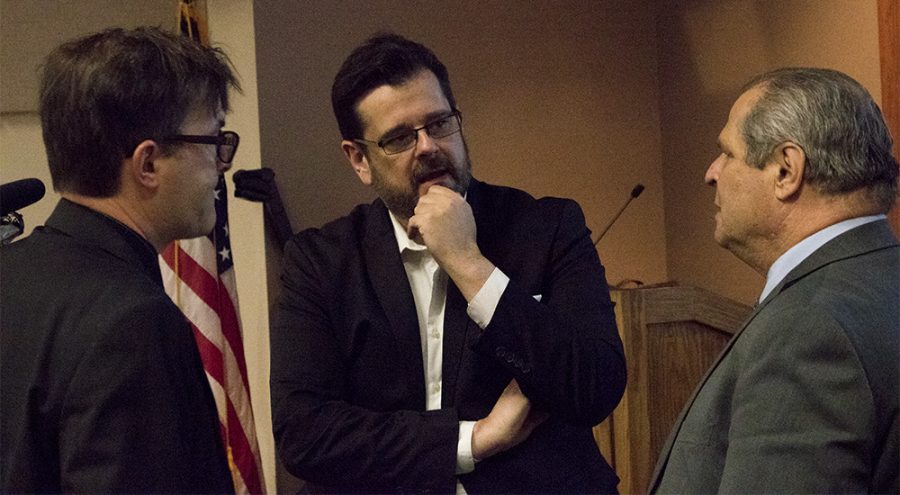Speaker discusses ‘Chile’s Woodstock’
Professor Patrick Barr-Melej (center), talks with C.C Wharram (left) the director of humanities center and Eastern President David Glassman (right) before he gives a lecture on his book “Psychedelic Chile” Tuesday night in Lumpkin Hall.
March 20, 2018
Patrick Barr-Melej, a history professor at Ohio University, spoke about sex, drugs and rock n’ roll Tuesday night in the Lumpkin Lecture Hall. His book “Psychedelic Chile: Youth, Counterculture, and Politics on the Road to Socialism and Dictatorship” is about “Chile’s Woodstock,” the landmark Piedra Roja music festival from 1970.
“My book, at its heart, is about people … I wanted to write a book that treats counterculture and the hippies seriously, instead of them being at the butt of jokes,” Barr-Melej said.
Barr-Melej said Chile’s political constituencies fanned the flames of moral panic against the hippies, but all they wanted to do was live their lives differently.
Barr-Melej’s story surrounds Jorge Gomez, a 19-year-old Chilean student who was inspired by screenings of the Woodstock film. Gomez decided to put on a free music festival, Piedra Roja, in the hills outside of Eastern Santiago. Gomez wanted to encourage the hippie counterculture movement known as hipismo, and unite both the rich and the poor through their shared love of music.
Nearly 5,000 young people attended the festival; most of whom had long hair, wore bell-bottom pants, smoked marijuana and even had sex in public.
The festival took place between Oct. 10 and 12, 1970, which was a month before the presidential election of Salvador Allende.
Allende was the first known Marxist to become president of a Latin American country through open elections.
Barr-Melej said social tensions were rising as the conservative right and liberal left were at political odds in the nation, and both were against the hipismo movement.
“During this era of the Cold War, the youth were forced to follow a grand narrative of either a socialist utopia or some capitalist success story for the developing worlds, but some young people decided that those grand narratives did not fit their lifestyles,” Berr-Melej said.
The hipismos quickly became attacked from both the right and the left; they were either labeled as hellish degenerates by traditional conservatives, or labeled as lazy bourgeois by the left. They ultimately became outcasts in their society, and were easily identified by their long, flowing hair.
Although many hipismos were persecuted and even killed for their lifestyles, their counterculture movement eventually became transnational. The “Woodstock Generation” was not confined to just Western nations anymore; it rippled across Latin America.
“It is an important fragment of Latin American studies and American politics through the involvement in the Chilean coup,” said Juan Nevarez, a graduate student in political science who helped sponsor the talk. “Counterculture and youth culture are important areas of historical and political aspects.”
Students who are interested in learning more about “Chile’s Woodstock” can attend a showing of retired biological sciences professor, Gary Fritz’s, film Piedra Roja at 7 p.m. Wednesday in the Doudna Fine Art Center’s Lecture Hall. The film is in Spanish with English subtitles.
Kaitlyn Ebert can be reached at 581-2812 or kmebert@eiu.edu.


![[Thumbnail] Eastern's Old Main was quiet Thursday morning while educators who had left the office to strike picketed outside.](https://www.dailyeasternnews.com/wp-content/uploads/2025/04/Strike_01_LT_O-800x1200.jpg)












![[Thumbnail Edition] Senior Foward Macy McGlone, getsw the ball and gets the point during the first half of the game aginst Western Illinois University,, Eastern Illinois University Lost to Western Illinois University Thursday March 6 20205, 78-75 EIU lost making it the end of their season](https://www.dailyeasternnews.com/wp-content/uploads/2025/03/WBB_OVC_03_O-1-e1743361637111-1200x614.jpg)















![[thumbnail edition] Assistant Coach of the Linebackers, Rodman Noel talking to the linebackers about their positions at O'Brien Field on the Eastern Illinois University campus, Charleston Ill.](https://www.dailyeasternnews.com/wp-content/uploads/2025/04/FB_24_O-1-e1744671213207-1200x609.jpg)








































